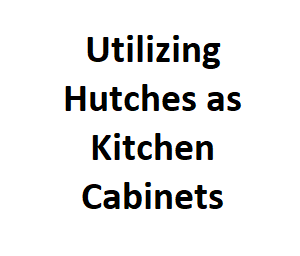When it comes to optimizing storage in your kitchen, traditional cabinets are often the go-to choice. However, if you’re looking to add a touch of uniqueness and character to your culinary space, consider repurposing a hutch as a kitchen cabinet. Hutches are versatile pieces of furniture that were traditionally used for storing and displaying dishes, glassware, and other collectibles. By incorporating a hutch into your kitchen design, you can achieve both functionality and style. In this blog post, we will explore the benefits and creative possibilities of utilizing hutches as kitchen cabinets.
Maximizing Storage Space
One of the primary advantages of using a hutch as a kitchen cabinet is the ample storage space it offers. Hutches typically have multiple shelves, drawers, and compartments, providing plenty of room to organize your kitchen essentials. The shelves can be adjusted or removed to accommodate items of varying heights, making it easier to store large appliances, cookware, and even pantry staples. With the additional storage options a hutch provides, you can keep your countertops clutter-free and create a more organized kitchen environment.
Showcasing Your Style
A hutch adds a unique element to your kitchen décor, allowing you to showcase your personal style and creativity. These versatile pieces come in various designs, from antique and rustic to modern and sleek. You can choose a hutch that complements your existing kitchen aesthetics or use it as a focal point to introduce a new design element. Whether you prefer a distressed farmhouse-style hutch or a sleek, contemporary one, it can become a statement piece that elevates the overall ambiance of your kitchen.
Mixing Storage and Display
Another advantage of using a hutch as a kitchen cabinet is the ability to combine storage and display areas in one piece of furniture. Hutches typically feature glass doors or open shelving, providing an opportunity to showcase your favorite kitchenware, collectibles, or decorative items. You can display a collection of vintage teacups, colorful glassware, or even cookbooks, adding personality and visual interest to your kitchen. By blending storage and display, you can create a functional and visually appealing space.
Versatility and Adaptability
Hutches offer great versatility and adaptability in terms of their functionality. While they are commonly used in dining rooms or living spaces, repurposing them as kitchen cabinets opens up a whole new range of possibilities. A hutch can be utilized to store and organize a variety of kitchen items, such as dishes, serving trays, linens, and small appliances. You can even convert a hutch into a coffee or beverage station by adding a built-in wine rack or coffee bar accessories. The flexibility of a hutch allows you to customize it according to your specific storage needs and preferences.
Budget-Friendly Option
If you’re looking for a budget-friendly alternative to traditional kitchen cabinets, repurposing a hutch can be an excellent choice. Hutches can often be found at thrift stores, antique shops, or online marketplaces at a fraction of the cost of brand-new cabinetry. With a little creativity and a fresh coat of paint, you can transform a dated hutch into a stylish and functional kitchen cabinet that perfectly suits your taste and budget.
Here are some additional ideas to enhance functionality and aesthetics:
Lighting:
Incorporate LED strip lights or under-cabinet lighting to highlight the display area of your hutch. This can create a cozy and inviting atmosphere, especially in the evening or when entertaining guests.
Organizational Accessories:
Install hooks, racks, or small baskets on the inside of the doors or sides of the hutch to hang utensils, measuring cups, or dish towels. This maximizes space utilization and keeps frequently used items within easy reach.
Glassware and China Display:
Arrange your cherished glassware or fine china on the top shelves of the hutch for a stunning visual display. Use plate stands or plate hangers to showcase decorative plates or platters.
Paint or Stain:
Consider painting or staining the hutch to match your kitchen’s color scheme or give it a fresh new look. You can opt for bold, vibrant colors to make a statement or choose neutral tones for a more subtle, elegant appearance.
Open Shelving:
Remove the glass doors from the hutch for an open shelving concept. This creates an airy and accessible storage solution for frequently used items or decorative pieces. You can add decorative baskets or bins to organize and conceal items that you don’t want on display.
Reclaimed Wood:
If you’re a fan of rustic or farmhouse-style kitchens, consider repurposing an old hutch using reclaimed wood. This adds character and warmth to your kitchen while giving a second life to salvaged materials.
Custom Backsplash:
Add a unique touch by installing a decorative backsplash behind the hutch. Use colorful tiles, patterned wallpaper, or even reclaimed wood panels to create an eye-catching backdrop that complements the hutch’s style.
Remember to measure the space where you intend utilizing hutches as kitchen cabinets, place the hutch to ensure a proper fit. Additionally, assess the hutch’s condition and structural integrity before repurposing it, making any necessary repairs or modifications.
In conclusion, utilizing hutches as kitchen cabinets brings both functionality and style to your culinary space. With its abundant storage, ability to showcase your personal style, and the opportunity for customization, a repurposed hutch can transform your kitchen into a unique and inviting haven. So, unleash your creativity and explore the possibilities of incorporating a hutch into your kitchen design.
